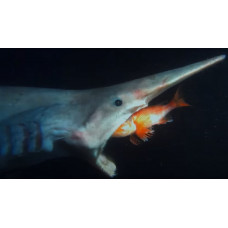Latin name
Mitsukurina owstoni
Other names
Owston's shark, Mitsukurina owstoni
Identification
The body is spindle-shaped and the fins have an unusual rounded shape for sharks. The third eyelid, lateral keels on the caudal peduncle and precaudal notch are absent. The protuberance on the snout contains a large number of electrosensitive cells and helps the shark to locate prey in the darkness of the deep sea. The liver is very large, up to 25% of the body weight (as in some other shark species, it replaces the swim bladder).
Teeth
The front teeth are long and sharp, with smooth edges, while the back teeth are adapted for crushing shells. The jaws are mobile and can extend outwards. The shark catches prey by extending its jaws and drawing water into its mouth along with the victim.
Features of fish fins
Anal and pelvic fins well developed and larger than dorsal fin. Upper lobe of heterocercal caudal fin strongly developed and resembling the tail of Thresher shark; lower lobe absent. Dorsal spines (total): 0; Dorsal soft rays (total): 0; Anal spines: 0; Anal soft rays: 0.
Fish colouring
Living individuals are pink in colour, after death they become brown. Fins are bluish.
Sailing speed
Slow moving sharks with neutral buoyancy.
Distribution
Most of these sharks have been found off the coast of Japan, in the area between Tosa Bay and the Boso Peninsula. They are also found in the western Atlantic: Guyana, Suriname and French Guiana. In the eastern Atlantic: France (Bay of Biscay), Madeira, Portugal and South Africa. In the western Indian Ocean: off South Africa. In the western Pacific: Japan, Australia (South Australia, New South Wales), New Zealand. In the eastern Pacific: USA (Southern California).
Habitat
Marine, bathydemersal, deep-water species. Occurs at depths of 30-1300 m, usually 270-960 m, in warm and temperate waters of all oceans. Occurs on outer continental shelves and upper slopes, but rarely in shallow waters close to shore.
Size
Males range in length from 2.4 to 3.7 metres and females from 3.1 to 3.5 metres. The largest known specimen was 3.8 metres long and weighed 210 kg.
Behavior
These carnivores are classified as solitary, they do not tend to form packs or groups regardless of habitat.
Food and feeding habits
It feeds on a variety of deep-sea organisms: fish, molluscs and crustaceans.
Reproduction
Nothing is currently known about the reproductive characteristics of these sharks other than that they are oviparous.
Development
The embryos feed on the yolk sac and other eggs produced by the mother.
Fishing
It has no commercial meaning.
Relationship with a person
Potentially dangerous to humans, but due to the fact that this shark is very rare and lives at great depths, there is virtually no chance of accidentally encountering it.
| Classification | |
| Phylum | Chordata |
| Class | Chondrichthyes |
| Squad | Lamniformes |
| Family | Mitsukurinidae |
| Genus | Mitsukurina |
| Species | M. owstoni |
| Features | |
| Conservation status | Least Concern |
| Habitat | Pelagic |
| Life span, years | No information |
| Maximum body weight, kg | 210 |
| Maximum length, cm | 380 |
| Sailing speed, m/s | No information |
| Threat to people | Not edible |
| Way of eating | Predator |
Goblin shark
Tags: goblin shark



